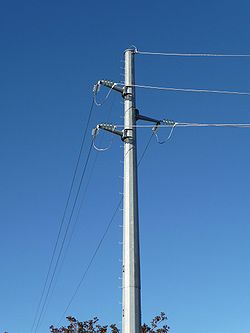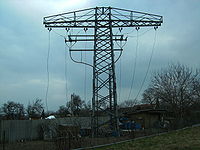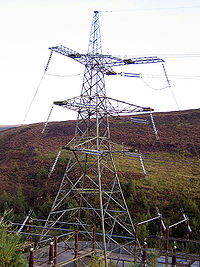
Dead-end tower
Encyclopedia

Strain insulator
A strain insulator is an insulator that provides both large electrical insulation and a large load-bearing capacity. Strain insulators were first used in telegraph systems to isolate the signal wire from ground while still supporting the wire...
s and occur at the endpoints of conductors. Such endpoints are necessary when interfacing with other modes of power transmission (see image) and, due to the inflexibility of the conductors, when significantly altering the direction of the tower line. Anchor pylons are also employed at branch points as branch pylons and must occur at a maximum interval of 5 km, due to technical limitations on conductor length. Conductors are connected at such pylons by a short conductor cable "strained" between both ends. They often require anchor
Soil kite
A kite has two parts—wing and tether. The tether is tensed; the wing converts the tension to lift and drag by interacting with a stream of material; the kite flies or deflects away from the relative direction of the ambient stream's material. When the ambient material is air, an air kite is...
cables to compensate for the asymmetric
Symmetry
Symmetry generally conveys two primary meanings. The first is an imprecise sense of harmonious or aesthetically pleasing proportionality and balance; such that it reflects beauty or perfection...
attachment of the conductors. Therefore, anchor pylons tend to be more stably built than suspension tower
Suspension tower
In an electric power transmission line, a suspension tower is where the conductors are simply suspended from the tower, the mechanical tension being the same on each side....
s and are often used, particularly in older construction, when the power line must cross a large gap, such as a railway line, river
River
A river is a natural watercourse, usually freshwater, flowing towards an ocean, a lake, a sea, or another river. In a few cases, a river simply flows into the ground or dries up completely before reaching another body of water. Small rivers may also be called by several other names, including...
, or valley
Valley
In geology, a valley or dale is a depression with predominant extent in one direction. A very deep river valley may be called a canyon or gorge.The terms U-shaped and V-shaped are descriptive terms of geography to characterize the form of valleys...
.


For voltages below 30 kV also pylon transformer
Pylon transformer
A distribution transformer is a transformer that provides the final voltage transformation in the electric power distribution system, stepping down the voltage used in the distribution lines to the level used by the customer. If mounted on a utility pole, they are called pole-mount transformers...
s are used.
For crossings of large bodies of water, wide freeways, or valleys, where the span width of the conductors is very long, specific constructions must be used to achieve a wider distance between the conductors, mostly to prevent short-circuits which may occur when conductors come in contact with one another due to wind or other interferences. These towers may be built as H-frame towers, or may have each conductor placed on a single tower or mast. In every case, these towers are built more stably than most of the other towers used, as the wide span between towers means that much greater forces are placed on these towers.
Anchor pylons may also have a circuit breaker
Circuit breaker
A circuit breaker is an automatically operated electrical switch designed to protect an electrical circuit from damage caused by overload or short circuit. Its basic function is to detect a fault condition and, by interrupting continuity, to immediately discontinue electrical flow...
attached to their crossbeam. These so called switch pylons are operated from the ground by the use of long rods. The attachment of circuit breakers to pylons is only practical when voltages are less than 50 kV.
Sequences of two or more strainer pylons are uncommon in a powerline because strainers require twice as many strain insulator
Strain insulator
A strain insulator is an insulator that provides both large electrical insulation and a large load-bearing capacity. Strain insulators were first used in telegraph systems to isolate the signal wire from ground while still supporting the wire...
s as ordinary pylons. Longer wire sections thus reduce installation work and cost. Sequences of strainers are sometimes used at powerlines crossing valleys, where often on both ends of the valley the pylons are powerlines, or where the powerline runs a path with curves.

Branch pylons frequently, but not always, have one or more cross beams transverse to the direction of travel of the line for the admission of the branching electric circuits; some also have cross beams of the branching electric circuits lying in the direction of travel of the main line. Branch pylons without additional cross beams are occasionally constructed.

